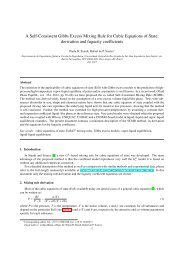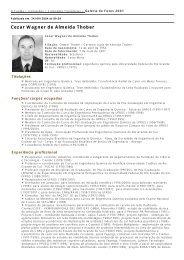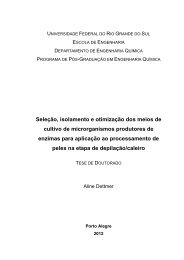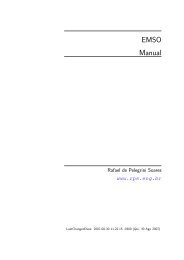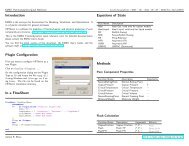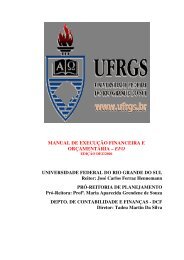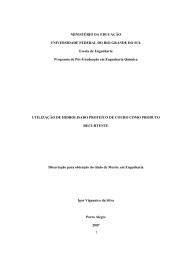derivation and fugacity coefficients - Ufrgs
derivation and fugacity coefficients - Ufrgs
derivation and fugacity coefficients - Ufrgs
You also want an ePaper? Increase the reach of your titles
YUMPU automatically turns print PDFs into web optimized ePapers that Google loves.
A Self-Consistent Gibbs Excess Mixing Rule for Cubic<br />
Equations of State: <strong>derivation</strong> <strong>and</strong> <strong>fugacity</strong> <strong>coefficients</strong><br />
Paula B. Staudt, Rafael de P. Soares ∗<br />
Departamento de Engenharia Química, Escola de Engenharia, Universidade Federal do Rio Gr<strong>and</strong>e do<br />
Sul, Rua Engenheiro Luis Englert, s/n, Bairro Farroupilha, CEP 90040-040, Porto Alegre, RS, Brazil<br />
Abstract<br />
The extension of the applicability of cubic equations of state (EoS) with Gibbs excess<br />
models to the prediction of high-pressure/high-temperature vapor–liquid equilibria of<br />
polar <strong>and</strong>/or asymmetric is well known. In a recent work (http://dx.doi.org/10.<br />
1016/j.fluid.2012.06.029) we have proposed the so called Self–Consistent Mix-<br />
ing Rule (SCMR). The method was derived solely based on the assumption of a zero<br />
excess volume liquid-like phase. Tests with substances dissimilar in size, shape <strong>and</strong><br />
chemical nature have shown that any cubic equation of state coupled with the pro-<br />
posed mixing rule can reproduce the underlying liquid activity model at low pressures,<br />
showing that the method is self-consistent. Further, the method was extended for high<br />
pressures/temperatures by assuming a constant thermal expansion coefficient liquid–<br />
like phase as the reference state. Very good results were obtained when the proposed<br />
method was coupled with Wilson, UNIQUAC, UNIFAC <strong>and</strong> a COSMO-based model<br />
in liquid–liquid <strong>and</strong> vapor–liquid equilibrium examples. The present document con-<br />
tains a minimum description of the SCMR method, its <strong>derivation</strong> <strong>and</strong> the equations for<br />
the <strong>fugacity</strong> coefficient.<br />
Key words: cubic equations of state, EoS/G E mixing rules, Gibbs excess models,<br />
vapor-liquid equilibrium, liquid-liquid equilibrium.<br />
∗ Corresponding author. Tel.:+55 51 33083528; fax: +55 51 33083277<br />
Email address: rafael@enq.ufrgs.br (Paula B. Staudt, Rafael de P. Soares)<br />
1
1. Introduction<br />
In a recent work (http://dx.doi.org/10.1016/j.fluid.2012.06.029) a new<br />
G E –based mixing rule for cubic equations of state was developed. The main advantage<br />
of the proposed method is that the combined model reproduces very well the G E γ model<br />
it is based on without any additional empirical correction.<br />
For a detailed description of the method as well as comparison with similar methods<br />
<strong>and</strong> experimental data, please refer to the full–length manuscript available at http://<br />
dx.doi.org/10.1016/j.fluid.2012.06.029. In this document only the mixing<br />
rule <strong>derivation</strong> <strong>and</strong> the <strong>fugacity</strong> coefficient equations are shown.<br />
2. Mixing rule <strong>derivation</strong><br />
Most of the cubic equations of state (EoS) available today are special cases of a<br />
general cubic equation [1], which can be written as:<br />
P = RT<br />
V − b −<br />
a (T)<br />
(V + ɛb) (V + σb)<br />
where P is the pressure, T is the temperature, V is the molar volume, ɛ <strong>and</strong> σ are con-<br />
stants for all substances <strong>and</strong> depend on the particular EoS (see Table 1) <strong>and</strong> a (T) <strong>and</strong> b<br />
are, respectively, the attractive <strong>and</strong> co-volume parameters specific for each substance.<br />
The attractive a (T) <strong>and</strong> co-volume b parameters are usually determined using gen-<br />
eralized correlations based on critical properties <strong>and</strong> acentric factor, according to:<br />
a (T) = Ψ α (Tr, ω) R 2 T 2 c<br />
Pc<br />
b = Ω RTc<br />
Pc<br />
where Tc is the critical temperature, Pc is the critical pressure, ω is the acentric factor,<br />
Tr = T/Tc the reduced temperature <strong>and</strong> the other symbols are shown in Table 1.<br />
2.1. Mixing rule<br />
When dealing with mixtures, the expressions for the attractive a <strong>and</strong> co-volume b<br />
parameters should be computed as a function of the pure substances values ai <strong>and</strong> bi<br />
through mixing rules.<br />
2<br />
(1)<br />
(2)<br />
(3)
Table 1: Specific cubic equation parameters.<br />
EoS α(Tr) σ ɛ Ω Ψ<br />
van der Waals (vdW) 1 0 0 1/8 27/64<br />
Redlich–Kwong (RK) T −1/2<br />
r 1 0 0.08664 0.42748<br />
Soave–Redlich–Kwong (SRK) αS RK(Tr; ω) a 1 0 0.08664 0.42748<br />
Peng-Robinson (PR) αPR(Tr; ω) b 1 + √ 2 1 − √ 2 0.07780 0.45724<br />
aαS RK(Tr; ω) = � 1 + (0.48 + 1.574ω − 0.176ω2 ) � 1 − √ ��2 Tr<br />
bαPR(Tr; ω) = � 1 + (0.37464 + 1.54226ω − 0.26992ω2 ) � 1 − √ ��2 Tr<br />
The van der Waals (vdW) or classic mixing rule, present in most professional pro-<br />
cess simulation systems, is given by:<br />
a =<br />
b =<br />
N�<br />
i=1<br />
N�<br />
i=1<br />
√<br />
xixj aia j(1 − ki j) (4)<br />
xibi<br />
where xi is the mole fraction of the substance i <strong>and</strong> ki j is the binary interaction param-<br />
eter, introduced to improve the correlation of phase equilibrium of mixtures.<br />
G E –based mixing rules, in contrast to the classic mixing rule, obtain the interac-<br />
tion information from excess Gibbs energy G E γ models, originally developed for the<br />
prediction of liquid activity <strong>coefficients</strong> γi.<br />
is [2]:<br />
One possible expression for computing the Gibbs excess energy from a cubic EoS<br />
G E φ<br />
RT<br />
�<br />
= ln φ −<br />
i<br />
xi ln φi<br />
where φ is the mixture <strong>fugacity</strong> coefficient <strong>and</strong> φi is the <strong>fugacity</strong> coefficient of the pure<br />
substance i, all in the same conditions of temperature <strong>and</strong> pressure.<br />
The <strong>fugacity</strong> coefficient considered in Equation 6 for any cubic EoS in the generic<br />
form (Equation 1) is given by [3]:<br />
ln φ = (Z − 1) − ln(Z − β) + qI (7)<br />
3<br />
(5)<br />
(6)
where Z ≡ PV/RT is the compressibility factor <strong>and</strong> the other auxiliary variables are:<br />
β ≡ Pb/RT, q ≡ a/bRT, I ≡ I0 ln V+ɛb<br />
V+σb , <strong>and</strong> I0 is a constant given by 1/(σ − ɛ).<br />
Using Equation 7 one can compute ln φ as well as ln φi by exchanging the mixture<br />
properties (Z, β, q, <strong>and</strong> I) by the pure substance properties (Zi, βi, qi, <strong>and</strong> Ii). Thus, by<br />
combining Equation 6 <strong>and</strong> Equation 7, the Gibbs excess energy for a cubic EoS can be<br />
computed by:<br />
G E φ<br />
RT<br />
�<br />
= (Z − 1) − ln(Z − β) + qI − xi ((Zi − 1) − ln(Zi − βi) + qiIi) (8)<br />
i<br />
Using the definition of excess volume V E ≡ V− � i xiVi <strong>and</strong> recalling that ln(Z−β) =<br />
ln P<br />
RT + ln(V − b) one can obtain:<br />
G E φ<br />
RT<br />
E PV<br />
=<br />
RT +<br />
� � �<br />
Vi − bi<br />
�<br />
xi ln + qI −<br />
V − b<br />
i<br />
i<br />
xiqiIi<br />
The expression given by Equation 9 contains no simplification assumptions <strong>and</strong> can<br />
be used to get a fully consistent mixing rule if we make G E φ = GE γ . Although exact, the<br />
practical use of Equation 9 is limited because it is an implicit mixing rule (the mixture<br />
volume V depends on q <strong>and</strong> vice–versa). Now, by assuming that the excess volume is<br />
negligible (V E = 0, V = V Id = � i xiVi) the following expression is obtained:<br />
G E φ<br />
RT =<br />
�<br />
i<br />
�<br />
Vi − bi<br />
xi ln<br />
V Id �<br />
+ qI<br />
− b<br />
Id −<br />
�<br />
i<br />
xiqiIi<br />
where b should be computed with the mixing rule Equation 5, the volume of the pure<br />
substances Vi, as well as I Id <strong>and</strong> Ii, should be computed using the liquid-like root of<br />
the pure fluids at the system temperature <strong>and</strong> pressure.<br />
(9)<br />
(10)<br />
However, for cubic equations, the attractive parameter a should depend on tem-<br />
perature <strong>and</strong> composition only. Since most G E γ are developed for near–atmospheric<br />
pressure, in this work the liquid–like root required for the determination of Vi is ob-<br />
tained at 1 bar. The results would be essentially the same if a zero pressure is taken<br />
as reference. Finally, by making G E φ = GE γ a new explicit mixing rule is obtained by<br />
isolating q in Equation 10:<br />
q = 1<br />
IId ⎛<br />
G<br />
⎜⎝<br />
E γ<br />
RT −<br />
� �<br />
Vi − bi<br />
xi ln<br />
V Id � �<br />
+<br />
− b<br />
i<br />
4<br />
i<br />
xiqiIi<br />
⎞<br />
⎟⎠<br />
(11)
The mixing rule given by Equation 11 will reproduce the G E γ model as long as the<br />
the system pressure is not too far from 1 bar <strong>and</strong> the zero excess volume assumption<br />
holds. For all tests considered (see the full-length manuscript) the GE φ reproduced the<br />
G E γ very well. Thus, the mixing rule given by Equation 11 was referred as the Self–<br />
Consistent Mixing Rule (SCMR). The <strong>derivation</strong> of <strong>fugacity</strong> <strong>coefficients</strong> of substances<br />
in mixture according to the SCMR is given in Section 3.<br />
2.2. Extension for high pressure/temperature<br />
In the mixing rule proposed in the present work, the pure fluid liquid–like volume<br />
of each substance in mixture is necessary. At high temperature conditions, usually<br />
above Tr ≡ T/Tc = 0.7, one can have problems with finding a liquid–like root from the<br />
cubic EoS.<br />
To circumvent this problem, an alternative procedure is adopted in this work to<br />
compute the pure fluid liquid-like molar volume to be used in Equation 11. From the<br />
definition of the volumetric thermal expansion coefficient of a pure fluid βi:<br />
βi ≡ 1<br />
� �<br />
∂Vi<br />
∂T<br />
Vi<br />
P<br />
<strong>and</strong> assuming a constant βi, evaluated at a reference temperature T ◦ i , the molar volume<br />
of a pure substance can be obtained by the following expression:<br />
ln Vi<br />
V ◦ i<br />
(12)<br />
= βi(T − T ◦ i ) (13)<br />
The pure fluid thermal expansion βi, according to an EoS, is easily determined by<br />
its definition (Equation 12). In this work, the reference temperature T ◦ i<br />
chosen was<br />
that to correspond to a Ti,r = 0.5. This temperature corresponds, approximately, to<br />
the normal boiling temperature. This reference temperature assures a valid liquid–like<br />
root, consequently no problems will occur to evaluate Vi.<br />
Then, in the SCMR mixing rule, the pure fluid liquid–like root Vi is always eval-<br />
uated by Equation 13, allowing its application to high pressure/temperature <strong>and</strong>/or su-<br />
percritical systems.<br />
5
2.3. Polymer solutions<br />
Specially for polymer components, the required pure component liquid-like vol-<br />
ume Vi = bi/ui was computed by considering a constant <strong>and</strong> universal value for the<br />
inverse packing fraction ui = 1.288. This value, taken from Sanchez <strong>and</strong> Cho [4],<br />
corresponds to the average value of the ratio of the van der Waals’ density <strong>and</strong> the<br />
characteristic density ρ ∗ , which is very chose to the Bondi constant 1.3[5]. With this<br />
assumption the liquid-like volume value, to be used by the mixing rule, is constant for<br />
pure polymers. The solvent liquid-like volume is still calculated using the volumetric<br />
thermal expansion coefficient, as explained in subsection 2.2.<br />
3. Fugacity <strong>coefficients</strong> from SCMR<br />
The <strong>fugacity</strong> coefficient of a substance i in a mixture, for any cubic EoS given by<br />
Equation 1, can be obtained by [3]:<br />
ln ˆφi = ¯bi<br />
b (Z − 1) − ln(Z − β) + ¯qiI (14)<br />
where ¯bi <strong>and</strong> ¯qi are partial molar properties defined by:<br />
� �<br />
∂nT k<br />
¯ki ≡<br />
∂ni<br />
with nT = � l nl.<br />
T,P,n j�i<br />
(15)<br />
For the SCMR mixing rule, the co–volume parameter b is given by the linear mix-<br />
ing rule, Equation 5, then ¯bi = bi.<br />
In order to simplify the notation in the <strong>derivation</strong> of ¯qi, let us introduce the quantity<br />
α for the SCMR mixing rule (Equation 11):<br />
α ≡ qI Id = GE γ<br />
RT −<br />
� �<br />
Vi − bi<br />
xi ln<br />
V Id � �<br />
+<br />
− b<br />
which leads to:<br />
¯qi = q + 1<br />
IId ⎛<br />
⎜⎝ ¯αi − α<br />
i<br />
Īi Id<br />
I Id<br />
⎞<br />
⎟⎠<br />
i<br />
xiqiIi<br />
<strong>and</strong> the remaining partial molar properties are:<br />
�<br />
Vi − bi<br />
¯αi = ln γi − ln<br />
V Id �<br />
+<br />
− b<br />
Vi − bi<br />
V Id − 1 + qiIi<br />
(18)<br />
− b<br />
6<br />
(16)<br />
(17)
Īi Id = I Id + I0<br />
�<br />
Vi + σbi<br />
V Id + σb − Vi + ɛbi<br />
V Id �<br />
+ ɛb<br />
where the activity coefficient γi should be computed by the chosen Gibbs excess model<br />
G E γ .<br />
References<br />
[1] J. O. Valderrama, Ind. Eng. Chem. Res. 42 (8) (2003) 1603–1618.<br />
[2] K. Fischer, J. Gmehling, Fluid Phase Equilib. 121 (1-2) (1996) 185–206.<br />
[3] J. M. Smith, H. C. V. Ness, M. M. Abbott, Introduction to Chemical Engineering<br />
Thermodynamics, McGraw-Hill, New York, 2005.<br />
[4] I. C. Sanchez, J. Cho, Polymer 36 (15) (1995) 2929–2939.<br />
[5] A. Bondi, van der Waals Volumes <strong>and</strong> Radii, J. Phys. Chem. 68 (3) (1964) 441–<br />
451.<br />
7<br />
(19)



